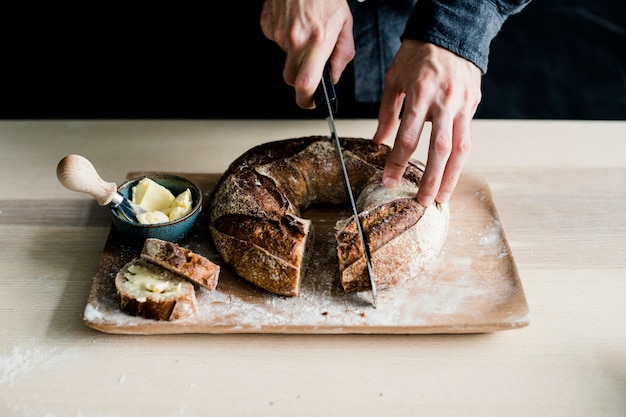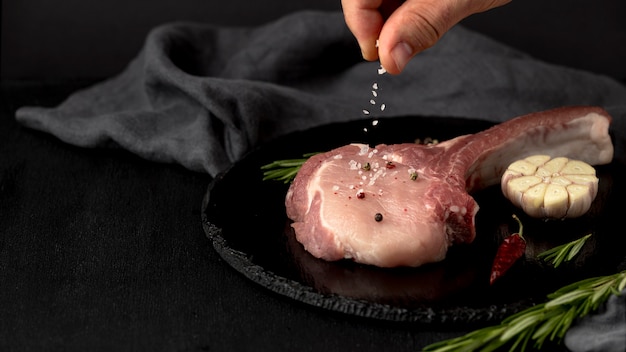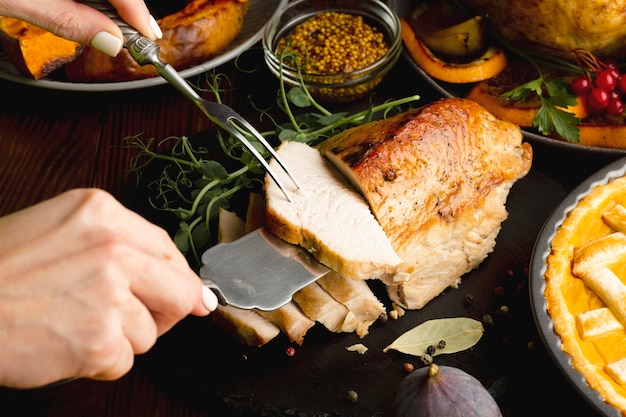I'll be honest, there's nothing quite like the smell of a perfectly roasted leg of lamb wafting through the house. The crispy skin, the succulent meat, the irresistible aroma... It's a culinary triumph, a feast for the senses! But, let's face it, nailing a deboned leg of lamb can feel a bit daunting, especially when it comes to getting the cooking times right. You don't want a dry, tough piece of meat, do you?
That's where I come in. I'm here to demystify the process and guide you towards that succulent, tender, and perfectly browned roast that'll have everyone clamouring for seconds. Whether you're a seasoned chef or a kitchen newbie, this guide is packed with tips and tricks to ensure your lamb is a triumph.
Let's embark on this culinary journey together! (Part 1)
choosing the right cut: A Foundation for Success

A deboned leg of lamb is a fantastic choice for roasting. It's a generous piece of meat, ideal for feeding a crowd. But remember, not all deboned legs are created equal. The key to an amazing roast lies in choosing a cut with a good amount of fat.
Now, you might think, "Fat? No thanks!" But trust me, that fat is your secret weapon for achieving that meltingly tender, flavourful meat we're aiming for. It renders during cooking, basting the lamb and adding incredible flavour. Look for a leg with a nice layer of fat, especially around the outside. You'll often see this described as "rolled" or "tied" – that's a sign the butcher has already done the legwork for you!
Deciphering the Options: Types of Deboned Leg of Lamb
Here's a quick breakdown of the most common types you'll encounter:
- Boneless leg of lamb: This is the most common and, in my opinion, the best for roasting. It's usually tied with string to maintain its shape during cooking.
- Butterflied leg of lamb: This is a butcher's masterpiece. They open up the leg, flatten it out, and often bone it, making it easier to cook and slice. Perfect for a crowd-pleasing feast.
- rack of lamb: While not technically a leg of lamb, it's a popular roasting option. It's a section of the rib cage, often left with the bones in, and makes for a stunning presentation.
Preparing Your Lamb: Setting the Stage for Success

Now that you've selected your perfect cut, it's time to prepare it for its grand entrance into the oven.
1. Pat it Dry: The Key to Crispy Skin
This simple step is crucial for achieving that beautiful, crispy skin we all crave. I use paper towels to pat the lamb dry, ensuring there's no lingering moisture to hinder the browning process.
2. Seasoning: The Flavor Foundation
This is where the real magic happens. I believe in keeping things simple, allowing the inherent flavour of the lamb to shine through.
For a classic roast, you can't go wrong with just salt and pepper. Generous amounts, please! I also love adding a touch of dried rosemary or thyme for a subtle, fragrant twist.
But, feel free to experiment! Garlic powder, paprika, even a pinch of cumin can add intriguing layers of flavour.
3. Optional: Scoring the Fat: A Finishing Touch for Crispy Perfection
Scoring the fat layer of your lamb is a step that can elevate your roast to a whole new level. It encourages the fat to render more evenly, creating a beautiful, crispy surface. Use a sharp knife to make shallow cuts, about half an inch apart, being careful not to cut through the meat. This is optional, but I find it makes a significant difference.
Choosing the Right Cooking Method: Your Culinary Canvas

Now, the fun part: deciding how to cook your deboned leg of lamb. You have a few options, each offering a unique result.
1. Roasting in the Oven: The Classic Approach
This is the traditional, time-honoured method for a reason. You get that gorgeous crispy skin and juicy, tender meat that everyone loves. I use a roasting pan that's large enough to accommodate the lamb comfortably, adding a splash of water to the bottom. This helps create steam, preventing the lamb from drying out and resulting in a moist, flavorful roast.
2. slow cooking: The Patience Pays Off Method
For a tender, melt-in-your-mouth lamb, slow cooking is a fantastic choice. It's ideal for those busy days when you need a stress-free dinner. Just pop the lamb into your slow cooker, set it to low, and let it do its thing. Remember, the key to slow cooking success is using a low temperature and cooking for a longer period to achieve that incredibly tender result.
3. Grilling: A Smoky, BBQ Delight
If you're after a smoky, barbecue-inspired flavour, grilling is a great option. Just make sure you use a grill with a lid, as this helps trap the heat and ensures a more even cook. Grilling is perfect for those warm summer evenings, adding a touch of outdoor flair to your culinary creations.
Calculating Cooking Times: The Art of Timing
Now, this is the crucial part: getting those cooking times right. Remember, every oven is different, so these are just guidelines. You'll want to keep a close eye on your lamb and use a meat thermometer to ensure accuracy.
Cooking Times Table: Your Guide to Perfect Doneness
The table below provides approximate cooking times for a deboned leg of lamb based on its weight. Remember, these are guidelines. Always check the internal temperature of the lamb to ensure it's cooked through.
| Weight (kg) | Cooking Time (per kg) | Internal Temperature (C) |
|---|---|---|
| 1.5-2 kg | 20-25 minutes | 60-65°C (medium-rare) |
| 2-3 kg | 15-20 minutes | 60-65°C (medium-rare) |
| 3-4 kg | 12-15 minutes | 60-65°C (medium-rare) |
Important Note: Always ensure your lamb is cooked to an internal temperature of at least 60°C (140°F) to ensure food safety. If you prefer a more well-done lamb, cook it to 70°C (160°F).
Resting Your Lamb: Letting the Juices Settle
Once your lamb is cooked to your desired level, resist the urge to carve it immediately. It's essential to let it rest for at least 15 minutes before slicing. This allows the juices to redistribute, resulting in a more succulent, tender piece of meat.
FAQs: Your Burning Questions Answered
Here are some common questions I get about cooking a deboned leg of lamb:
1. What Temperature Should I Cook My Lamb?
It really depends on your preference. I generally aim for medium-rare, which is around 60-65°C (140-150°F). For medium, you'll want to cook it to 70°C (160°F).
2. How Do I Tell If My Lamb Is Done?
The most reliable method is using a meat thermometer. Insert it into the thickest part of the lamb, avoiding any bone. But you can also use the "squeeze test". If the lamb feels firm but springs back when you press it, it's medium-rare. If it feels firmer, it's more well-done.
3. Can I Cook My Lamb in Advance?
Absolutely! You can cook your lamb a day or two ahead of time. Just let it cool completely before wrapping it tightly in cling film and storing it in the fridge. To reheat, simply place it in a preheated oven at 160°C (325°F) until it's heated through.
4. What Should I Serve with My Lamb?
The world is your oyster! I love pairing it with roasted vegetables like carrots, potatoes, and onions. A simple green salad is also a refreshing accompaniment. And, of course, you can't forget the mint sauce – it's a classic pairing for a reason.
5. What If My Lamb Is Overcooked?
Don't despair, it happens to the best of us! If your lamb is overcooked, it's likely to be a bit dry. But don't fret, there are ways to salvage it. Try adding a bit of broth or gravy to the pan and simmering the lamb for a few minutes to rehydrate it.
Conclusion: A Celebration of Flavour
And there you have it! Your comprehensive guide to cooking the perfect deboned leg of lamb. Remember, it's all about choosing the right cut, preparing it well, and cooking it to your desired level of doneness.
Now, go forth and wow your guests with a succulent, flavourful roast that will have everyone raving about your culinary skills. Happy cooking!
Everyone is watching

Corn on the Cob: The Ultimate Guide to Perfectly Cooked Ears
Healthy MealsAh, corn on the cob. Just the name evokes images of sunny days, barbecues, and that sweet, juicy flavour that ...

Perfect Pork Roast Oven Cooking Time: A Guide to Delicious Results
Healthy MealsThere's something truly satisfying about a perfectly roasted pork. The aroma alone is enough to make your mout...

Ham Cooking Time: How Long to Bake, Smoke, or Boil a Delicious Ham
Healthy MealsAh, ham. It's a classic, isn't it? A real crowd-pleaser, especially around holidays. And when done right, it'...

Scallops: The Ultimate Guide to Perfect Cooking
Healthy MealsAh, scallops. Those delicate, sweet, and utterly delicious morsels of the sea. They hold a special place in my...

Spaghetti Squash: The Ultimate Guide to Cooking and Serving
Healthy MealsRemember that time you saw spaghetti squash at the supermarket, looking all bumpy and strange, and thought, "W...
